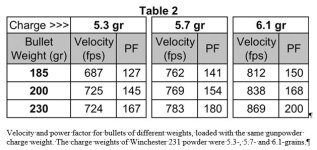In this case. the same powder charge does not produce the same force. If the 185 grain bullet is loaded to the same OAL as the 230 grain bullet, then there is more volume in the cartridge behind the bullet.
IF. If loaded to the same COL, yes. But not all are. If the bullets are loaded to the same depth in the case, then the powder space will be the same, and the COL will be different.
I think the OP was saying "same powder charge" for both bullets, meaning the same amount of "chemical energy" being applied to both bullets. And, I think the way he worded it is causing us a bit of confusion about what he's actually trying to find out. Both of his posts use terms in ways that lead me to think he doesn't understand some things the way we do.
I suggested considering spring driven bullets as a way to illustrate a constant and equal force, and avoid all the many different factors that can change the pressure of powder charges, in order to focus on what I think the OP was asking about, why "equal force" gave different KE results.
I think all the detailed explanations of powder behavior in the thread have been accurate and correct, but, so far, it seems the OP has not been able to grasp that and we won't know until he posts again.
I think his question is essentially, "if you push them equally, why do you get such different results", and I think he just assumed equal powder charges push them equally and is not aware of the factors that can result in the same powder charge yielding different pressures.
To get to equal pressure/force, we need to increase the powder charge for the 185 grain bullet compared to the 230 grain bullet. That is supported by data in every reloading manual that I have. There is no mystery here, the premise of a 185 grain bullet having more KE than the 230 grain bullet with the same powder charge with all other factors held constant is inconsistent with actual data.
I disagree. I just don't see things that way, absent more information relating to the specific loads. Here's my viewpoint, and, its going to contain that dreaded word "if".

IF the powder space in the case is the same (and it may not be, but IF it is) how can the same amount of powder, in the same amount of space produce different pressure??
COL is not an accurate representation of the amount of powder space. I have a Hornady book showing 2 different 185gr and 2 different 230gr bullets and the COL for each one is different. Hornady might be seating these bullets so the depth of the bullet base in the case is the same (which would make the available powder space the same) but there is no information given saying that is what they do. I guess it is implied, but not stated??
Loading different length bullets to the same COL, obviously means the bases are at different positions inside the case, and so the powder space will be different. SO, as I see it, COL can give you an indication, but not an actual amount without additional information.
Also, with all other factors held constant, won't the lighter bullet have higher velocity, and therefore the formula will result in a higher KE number due to the difference in mass not being as much of a factor in the formula as the difference in velocity, squared?
Perhaps the OP assumed that the same powder charge would result in the same pressure, but that is an incorrect assumption. We really need the OP to explain how the velocity numbers in his post were generated.
this, I can absolutely agree with.

